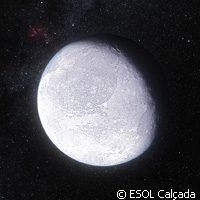Astronomers pinpoint Pluto's long lost twin
For the first time, a team of astronomers has successfully taken accurate measurements of the diameter of the distant dwarf planet Eris by catching it as it passed in front of a faint star. The observations were made using telescopes located at the European Southern Observatory's (ESO) La Silla Observatory in Chile and they show that Eris is nearly exactly the same size as Pluto, putting to bed earlier claims by scientists that Eris was 25% larger than Pluto. The team, who hail from Argentina, Belgium, Brazil, Chile, France, Germany, Italy, Spain, Switzerland, Mexico and the United Kingdom, explain in a new study published in the journal Nature how they made the observations in November 2010 when Eris passed in front of a faint background star, an event also known as 'occultation'. Despite being rare events - the next time it will occur will be in 2013 - and tricky to capture due to the distance, occultations remain the best way to measure a distant Solar System body like Eris, as the study's lead author Bruno Sicardy from the Centre National de la Recherche Scientifique (CNRS) in France explains: 'Observing occultations by the tiny bodies beyond Neptune in the Solar System requires great precision and very careful planning. This is the best way to measure Eris's size, short of actually going there.' To be sure they didn't miss this once in a blue moon chance, astronomers - both professional and amateur - attempted observations of the occultation from 26 different locations around the world on the predicted path of the dwarf planet's shadow. But only two sites were able to observe the event directly, and both of them were located in Chile. One was at ESO's La Silla Observatory and the other was located in San Pedro de Atacama on two different telescopes. All three telescopes recorded a sudden drop in brightness as Eris blocked the light of the distant star. These observations combined indicate that Eris is close to spherical and the astronomers also spotted that Eris has a very reflective surface suggesting it is covered in a thin layer of ice. It reflects 96% of the light that falls on it and the team believes it most likely has a frozen atmosphere. This means Eris is one of the most reflective objects in the Solar System, along with Saturn's icy moon Enceladus. 'This layer of ice could result from the dwarf planet's nitrogen or methane atmosphere condensing as frost onto its surface as it moves away from the Sun in its elongated orbit and into an increasingly cold environment,' comments another study author Emmanuel Jehin from the Institut d'Astrophysique de I'Université de Liège in Belgium. It was back in 2005 when Eris was first identified as a large object in the outer Solar System and its discovery was one of the factors that led to the creation of a new class of objects called dwarf planets and the subsequent reclassification of Pluto from planet to dwarf planet in 2006. Bruno Sicardy reflects on the project: 'It is extraordinary how much we can find out about a small and distant object such as Eris by watching it pass in front of a faint star, using relatively small telescopes. Five years after the creation of the new class of dwarf planets, we are finally really getting to know one of its founding members.' And although we can describe Eris as a relative 'twin' for Pluto we can hardly call them a close-knit pair as Eris is currently three times further from the Sun than Pluto.For more information, please visit:European Southern Observatory:http://www.eso.org/public/
Countries
Argentina, Belgium, Brazil, Chile, Germany, Spain, France, Italy, United Kingdom



